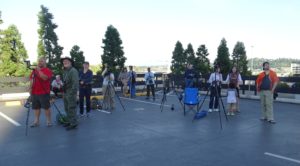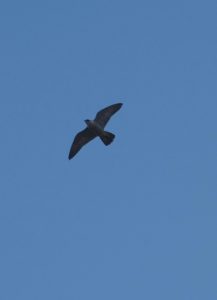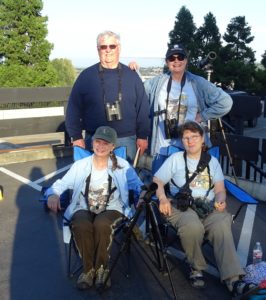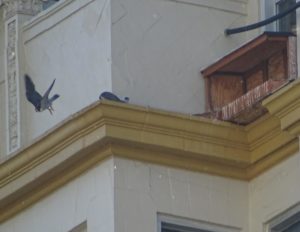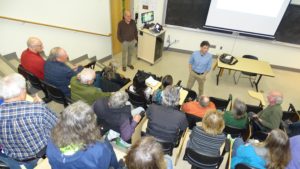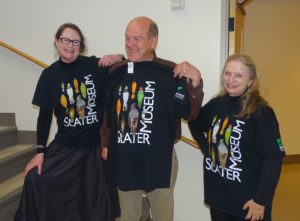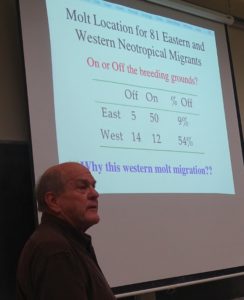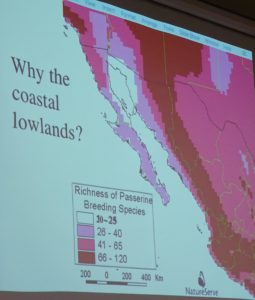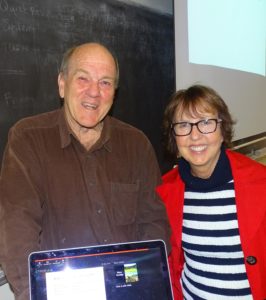A flash mob materialized after only 2 days’ notice on the evening of Memorial Day in downtown Tacoma to check on the happy family of peregrines, Murray and Harriet and their four chicks, three males and one female, Jake, Chris, Eeyore, and Hope. The names were picked in a contest drawing by Tahoma Audubon and were assigned after banding revealed the genders of the chicks.
Lots of you came and were not disappointed! Guests of honor were Fergus Hyke, a professional-level photographer who has been monitoring the birds from his office in their building on behalf of FRG (Falcon Research Group, Bud Anderson’s organization), as well as TAS President Jerry Broadus and local raptor expert Roger Orness who participated in the banding operation.
This turned out to be one of the first days that the chicks left the nest, “branching” out onto the art-deco ledge of the 17th floor of the Heritage Bank Building, best viewed from various spots on 12th Street looking north. We were treated to Peregrines flying over our heads, negotiating the canyons of skyscrapers expertly, while Rock Pigeons went about their business with an eye to the sky. One of the falcons spent considerable time plucking a pigeon one building east of the nest, feathers snowing down like cottonwood seeds. Soon pieces were brought to the chicks, who were enthusiastic eaters. The parents used the food to lure the chicks ever further from the comfortable and luxurious penthouse provided by falcon lovers.
This drama will be ongoing, and all of you are urged to look up from this intersection in Tacoma and see what’s happening and tell your friends, but soon!
It is thought that the chicks will fledge within a couple of weeks. This will be a time of vigilance for all of us, as we watch for chicks suddenly appearing on the busy roadway. Jerry says they are approachable and can be picked up at that stage. Take it into the building. The security people can get it to Fergus or someone to put it back in the nest box.
Some of Fergus’ great shots of this family close up, as well as by others who have been able to see these birds head to head are on the Tahoma Audubon website at http://www.tahomaaudubon.org/Peregrine-Falcons-Downtown-Tacoma, as well as on the TAS Facebook page.
More photos by others taken from the ground are on the TAS FLICKR site: https://www.flickr.com/photos/tahomaaudubon/albums/72157681477342223
More photos have been added recently by Heather Roskelley, who seems to be specializing in bloody prey shots!!
Downtown Tacoma has been the site of almost continuous Peregrine nesting attempts since the 1990s, first on the Murray Morgan 11th Street bridge, just a stone’s throw from the current nest. In fact, the dad of the current family, “Murray,” was fledged and banded on that bridge 13 years ago, so he’s getting to be an old guy. He’s had many mates over the years and has had great success at the present nest box site for the past several years. Jerry tells us there is another Peregrine family under the highway 509 bridge right now who also have 4 chicks.
What a wonderful adaptation this proud species of raptor has made since coming back from the brink during the DDT years!
Go there! See them!
NEWS FLASH! Just after this was posted, the Tacoma News Tribune published a story on the Peregrine family:
http://www.thenewstribune.com/outdoors/article153431734.html
UPDATE – JUNE 16, 2017: After Chris’ sad demise, it was heartening today from Jerry & Fergus to hear that Hope was out of rehab after her fledging misadventure. Roger is also out there, still waiting to see whether she’ll be okay. A watcher in a nearby building said she was holding her wing a little askew. X-rays have shown no break.
Yesterday during the Tall Ships’ arrival, a Peregrine was seen flying in the area by Diane and Adam, although they were not very close.
New photos have been posted on both websites above (Tahoma Audubon and FLICKR).

